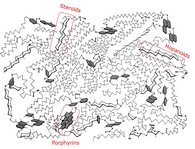Quick Bound Biomarkers
Background
Biomarker carbon skeletons occur in both free and bound forms in sedimentary organic matter. Covalently bound steroids and hopanoids have been documented in humic substances, kerogen and petroleum asphaltenes. The ratio of free to bound occurrence in source rocks is in part a function of organofacies, and thus Type I kerogen has a small bound fraction, at which Type IIS is dominated by bound biomarkers. In contrast to the free biomarker, the bound biomarker fraction is less susceptible to contamination and biodegradation, and, therefore continues to provide key information on the organic matter source and thermal maturation. Open system pyrolysis in high pressure hydrogen (HyPy) and selective chemical degradation are the techniques most frequently employed to release bound biomarkers. We have developed and currently improve a new less elaborate method to release bound biomarkers: The micro-scale sealed vessel catalytic hydrogenation (MSSV-HY) method, which utilizes tetralin and various catalysts. Preliminary results manifest that the MSSV-released bound biomarkers are highly comparable to the free biomarkers in the source rock or reservoir oil.
Goals
Testing the applicability of the new method in oil-source and oil-oil correlations when the routine (free) biomarkers are not reliable caused by biodegradation, contamination, or thermal maturation.
Participants
- Dr. Shengyu Yang
- Prof. Brian Horsfield
- Dr. Kai Mangelsdorf
Funding
IPP (Industry Partnership Programme):
- Aker BP
- Lundin
- Repsol
- Total



